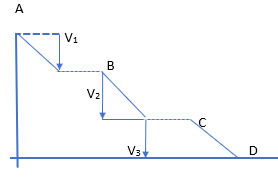Resistances in Series
When some conductors having resistances R1, R2, and R3 etc. are joined end on end as in figure below they are said to be connected in series. It can be proved that the equivalent resistance or total resistance between points A and D is equal to the sum of the three individual resistances. Being a series circuit, it should be kept in mind that
But V = IR
where R is
the equivalent resistance of the series combination.
IR=IR1
+ IR2 + IR3
Req=R1+R2+R3
Resistances in Parallel
Three
resistances, as joined in Figure 4, are said to be connected in parallel. In
this case
(i) potential
differen (V) across all resistances is the same
(ii) current in each resistor is different and
is given by Ohm's Law and
(iii) the total current is the sum of the three separate currents
I = I 1
+ I2 + I3 =
V/R1 + V/R2 + V/R3
I = V/R
where V is applied voltage
R = equivalent
resistance of the parallel combination.
V/R = V/R1 + V/R2 + V/R3
OR
1/R = 1/R1
+ 1/R2 + 1/R3
Example 1
Calculate
the effective resistance of the following combination of resistances and the
voltage drop across each resistance when a P.D (potential different) of 60 V is applied between
points A and B.
Solution:
RESISTANCE
(i) Resistance betweet A dan C
in this circuit we use parallel resistance formula
RAC =
(ii) Resistance of branch ACD
in this circuit we use series resistance formula
RACD = RAC + RCD = 2 + 10 = 12 Ω
(iii) Resistance betweet A dan D
in this circuit we use parallel resistance formula
now there are two parallel path between point A and D of resistance 12 Ω and 6 Ω. hence,
resistancce point A and D
RAD = (12 x 6)/(12+6) = 4 Ω
***** Resistance between A dan B ***
in this circuit we use parallel resistance formula
RAB =
CURRENT
(i) total circuit current
Itotal = V/RAB = 60 / 10 = 6 A
(ii) current through 6 Ω (R5 ) resistor
IR5 = Itotal x RACD / (RACD + R5)
= 6 x 12/18
= 4 A
(iii) current in branch ACD
IACD = Itotal x R5 / (RACD + R5)
= 6 x 6/18
= 2 A
POTENTIAL DIFFERENT
(i) PD across R1 and R2 = IACD x RAC = 2 x 2 = 4 V
(ii) PD across R3 = IACD x RCD = 2 x 10 = 20 V
(iii) PD across R4 = Itotal x RDB = 6 x 6 = 36 V
(iv) PD across R5 = IR5 x R5 = 4 x 6 = 24 V





Komentar
Posting Komentar